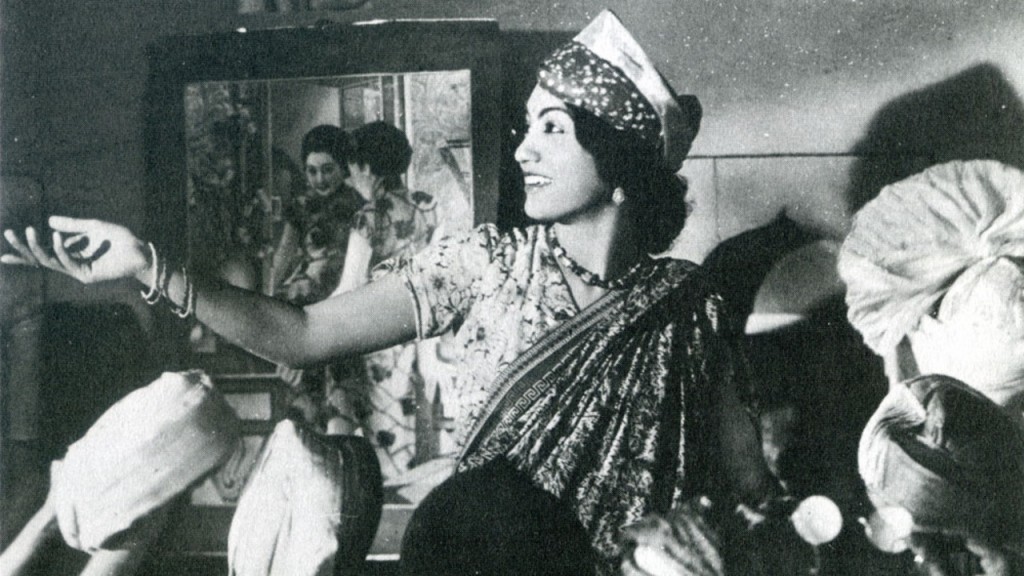Policeman Ganpat (Shahu Modak) saves prostitute Maina (Shanta Hublikar) from a police raid on a brothel. They fall in love. However, her reputation and sense of guilt resist his attempts to rehabilitate her. Ganpat’s respectable middle-class mother (Sundarabai) symbolizes what he would like Maina to be like. But feeling her past would always catch up with her, Maina leaves Ganpat. She is later arrested for killing her wicked uncle but refuses Ganpat’s offer to release her from prison.
Manoos is regarded as one of V Shantaram’s finest films. It might well be so for Manoos is significant not only in terms of its socially relevant thematic content but also for its technical innovations and artistic integrity, particularly in the use of physical spaces to represent mental states of the characters.
The film builds up the relationship between Ganpat and Maina beautifully, giving it much heart and soul. As the two of them get closer, there is a lovely if overlong comical sequence wherein Maina and Ganpat blunder on to a film set. Shantaram uses the occasion to include a delightful spoof on the rival studio, Bombay Talkies’ kind of cinema. The hero and anglicized heroine of the film sit by a tree and mouth sweet nothings to each other and even begin singing a song live with the orchestra playing live similar to Ashok Kumar and Devika Rani in Achhut Kannya (1936). Ganpat and Maina crack up at the heroine’s dialogue delivery and break out into song themselves., the entire orchestra playing live follow them! And after seeing Ganpat and Maina sing the song, the director offers roles to the two of them causing the Anglo-Indian film heroine who speaks and sings with an English accent to remove her dark long wig and sari and walk away in a huff in a western dress! Musically though, the biggest hit of the film was the multi-lingual song Kashalya Udyachi Baat set in Tamil, Telugu, Bengali, Gujarati and Punjabi in addition to its Marathi refrain as Maina entertains her clients who are from all over India. This song is also a kind of spoof alluding to familiar stereotypes from the corresponding film centers.
The film is almost entirely shot on sets including the street corners, alleys, corridors etc. and consists mainly of night scenes often in heavy shadows. The spaces are used particularly well to represent the mental states of the characters like the key sequence highlighting Maina’s dilemma that she can neither come to terms with her past nor her present. Maina and Ganpat’s mother are both lying side by side in the prayer room. While the old woman is peacefully asleep, the former is visibly agitated. Her hand accidentally touches the tanpura used by the old woman during her prayers. The tanpura strikes a chord. With utmost economy and in a quick montage of shots of Maina, the deity, the prayer book, the flickering light of the oil lamp Shantaram is able to show her state of mind in a purely cinematic language.
The film sees charming performances from its lead pair and has you rooting for them big time. Shanta Hublikar became an icon in Marathi Cinema with her role as Maina. In fact, Kashalya Udyachi Baat was also the title of her autobiography (1990). Modak too became a top Marathi star following Manoos. But his earlier reputation in contemporary socials like Manoos was later superceded by his overwhelming success in Sant Dnyaneshwar (1940) after which he acted in mainly mythologicals. He went on to play Krishna in 29 films in Marathi, Hindi and Bhojpuri!
Sadly, like Shantaram’s earlier Kunku (1937), what really disturbs one in Manoos is the film’s ending. By refusing a better life for herself and going back to where she came from, the whore feels she is not fit for a normal life – once a whore, always a whore. Thus, the film ends up with a situation, which is a kind of status quo without any solution in sight and an outlook that is far from revolutionary.
Marathi, Drama, Black & White


